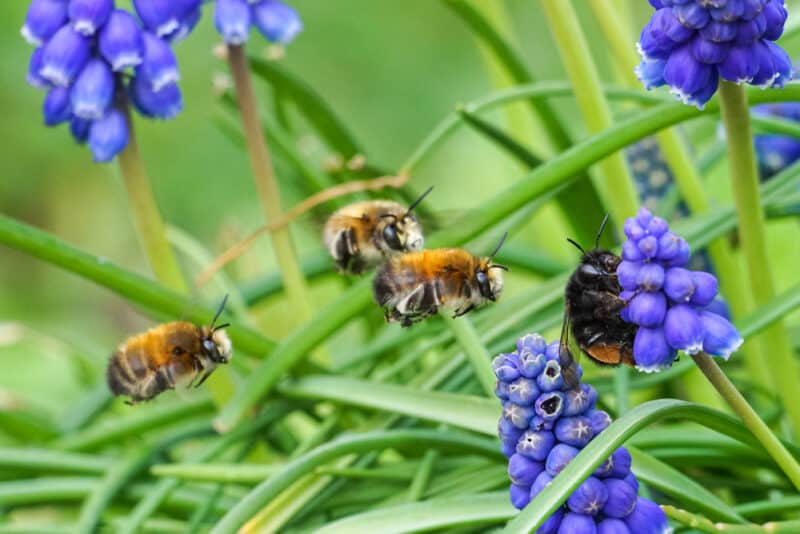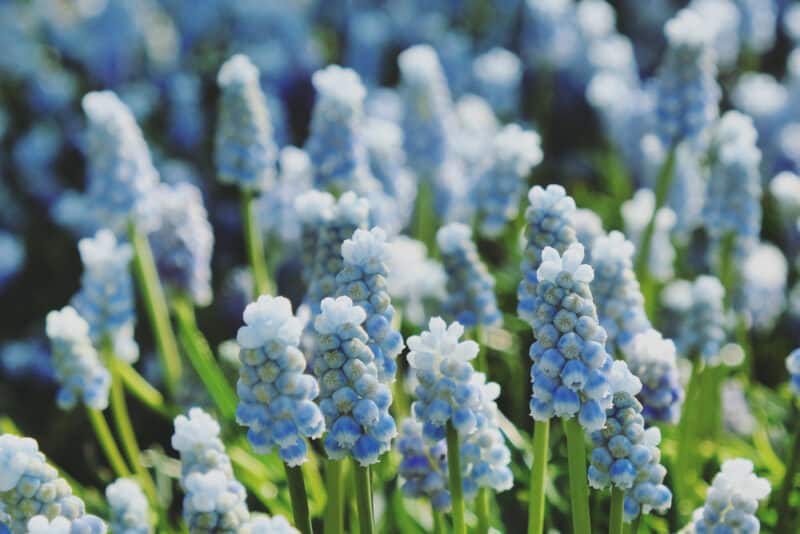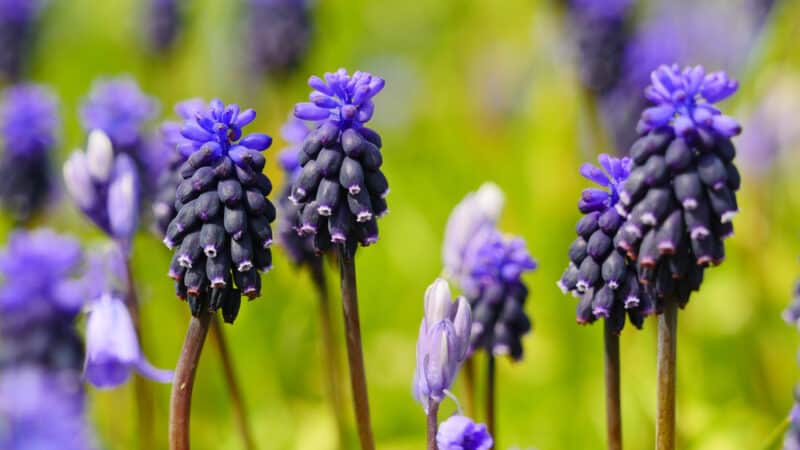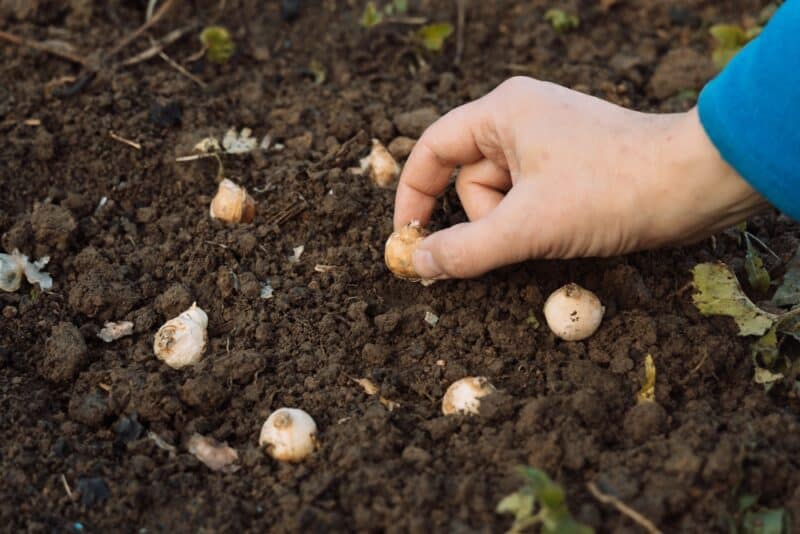Although this little plant has a short blooming period, grape hyacinth makes a big impact in the garden. Available in multiple colors, it creates texture and color that stands out from other plants in the garden.
They’re perfect for mass planting in an area where you don’t mind them spreading, and they also look great in containers where they will happily add color to decks and outdoor seating areas.
Armenian grape hyacinth (Muscari armeniacum) is a charming spring-blooming bulb that produces beautiful displays of purple, blue, or white bell-shaped flowers. However, these lovely flowers can sometimes become infested with aphids, a common garden pest Here are effective methods to get rid of aphids on your grape hyacinths
What are Aphids?
Aphids are tiny, soft-bodied insects that feed by sucking sap from the stems, leaves, and flowers of plants. They excrete a sticky substance called honeydew which can promote mold growth. Aphids multiply rapidly and infestations can quickly get out of control.
Several species of aphids attack grape hyacinths and other ornamental bulbs including blue green aphids bulb aphids, and cotton aphids. They are typically found on young succulent growth. Watch for clusters of these pear-shaped insects on flower stalks, leaf tips, and buds.
How Aphids Damage Grape Hyacinths
Aphids extract sap as they feed depriving the plant of essential nutrients and energy. Moderate to heavy aphid populations can severely weaken and stunt grape hyacinth plants. Impacts include
- Distorted, curled leaves and deformed flowers
- Poor or failed flower blooms
- Yellowing foliage
- Premature death of leaves and flowers
- Sticky honeydew on plants that leads to sooty mold
- Spread of harmful plant viruses
Catching infestations when they first start is key to limiting damage.
Eco-Friendly Ways to Control Aphids
For mild aphid infestations, try these organic, non-toxic control methods first:
-
Strong water spray – Blast plants daily with a strong jet of water to knock aphids off plants.
-
Insecticidal soap – Spray on plants to kill aphids on contact while safely breaking down after application.
-
Neem oil – Derived from the neem tree, it smothers and kills aphids while low toxicity to beneficial insects and pollinators.
-
Horticultural oils – Suffocate aphids while providing benefits to the plant. Use dormant oil formulations in spring and summer.
-
Diatomaceous earth – This abrasive powder desiccates aphids when applied as a dusting on plants. Reapply after rain or watering.
-
Attract predators – Ladybugs, lacewings, hoverflies and many other beneficial insects devour aphids. Plant flowers they like to invite them to your garden.
Chemical Pesticides for Serious Infestations
For heavy aphid infestations, contact insecticides may be warranted:
-
Insecticidal soaps – Potassium salts of fatty acids kill aphids on contact while breaking down quickly to pose minimal risk.
-
Botanical insecticides – Pyrethrins, azadirachtin and other plant-derived chemicals provide safe, effective control when rotated.
-
Horticultural oils – Light oils smother and kill all life stages of aphids, including eggs. Useful to kill overwintering eggs.
-
Systemic insecticides – Taken up by plants, they provide residual control as aphids feed. Imidacloprid and thiamethoxam products can be applied to the soil or foliage.
Carefully follow all label instructions when using insecticides. Avoid applying them during bloom to prevent harming pollinators. Scout plants routinely and re-apply products as needed every 7-14 days while the infestation persists.
Preventing Aphid Infestations
Good cultural practices are key to deterring aphids in your grape hyacinth planting:
-
Inspect plants routinely for pests and treat early before infestations intensify.
-
Remove and destroy severely infested bulbs and plants to prevent spread.
-
Hose off plants with a strong spray of water to dislodge aphids.
-
Apply row covers over plants in fall and early spring to form a barrier against aphids.
-
Control weeds around bulb beds that may harbor aphids.
-
Space bulbs properly to allow air circulation and prevent humidity that attracts pests.
-
Apply a 2-3 inch layer of mulch to prevent weeds and shelter aphids at plant bases.
With persistence and repeated applications of organic and/or chemical controls, you can eliminate destructive aphids from your grape hyacinth collection. The reward will be healthy, vigorous plants and bountiful blooms.

What is Grape Hyacinth?
Grape hyacinth (Muscari spp.) is a spring-flowering perennial bulb that flowers early and suits many conditions in the garden or containers.
It is native to Eurasia but some species have naturalized in other parts of the world. The genus name is Greek, referring to the musk-scented flowers that explode in early spring.
Despite the name, grape hyacinth isn’t a hyacinth, but is part of the lily family (Liliaceae). The word grape refers to the cluster of pretty bell-shaped flowers that resemble an upside-down bunch of grapes.

The leaves will appear first in early spring before the flowers follow. The foliage dies off in early summer after flowering. A bonus of grape hyacinth is that some will grow again in mid-fall. If you live in an area with mild winters, you could be lucky and have a second round of grape hyacinth color.
The flowers are four to eight inches tall, with an average three stalks per bulb. Each stalk has around 20 to 40 flowers tightly packed. Some cultivars might be much taller or even a bit smaller.
Generally, these plants grow in USDA Hardiness Zones 4 to 8.
5 of the Best Species of Grape Hyacinth
It’s worth noting that many garden centers sell grape hyacinth under the common name “grape hyacinth” rather than defining the species. It is essential to know the species for propagation, though.
When you shop for grape hyacinth, you will see just how many varieties and cultivars there are. Here are some favorites, but if you can’t find them, you will probably find some that you love at your local nursery.

Armenian grape hyacinth (M. armeniacum) is indigenous to Europe but has naturalized across North America. You will often find them in meadows and woodlands. Plant these in pots or mass planting situations. They will produce daughter bulbs.
‘Peppermint’s’ blooms are initially white before turning a light blue flower with white tips. ‘Peppermint’ is a vigorous grower and a reliable bloomer. In mass planting situations, the white tips give a snowy or icy look.
‘Blue Spike’ is an unusual-looking grape hyacinth because it is double-flowered, making it look much bigger than others. The blooms are a darker blue than the peppermint.
‘Siberian Tiger’ has pure white flowers that create a carpet of brilliant whiteness. Seeing is believing just how bright white the blooms are.

Ideal for warmer areas, common grape hyacinth (M. neglectum) produces daughter bulbs and can readily form clumps that return year after year.
Mix sky-blue with delicate grey, and you have ‘Baby’s Breath.’ This cultivar is easy to grow and prolific.
The blooms on ‘Valerie Finnis’ start out a light shade of blue. As the season goes on, the blue becomes much more vivid. Lovely for gardeners who like to see changes in color as the seasons mature.
Have a sunny to semi-shady spot? Broad-leaved grape hyacinths (M. latifolum) are perfect. They are the most vigorous species and grow up to 10 inches tall.
If you love contrasting colors, try ‘Grape Ice.’ The blooms start out as white and turn to very dark purple as they mature. Seeing the contrast between the white and purple flowers as they change is a great look for the garden.
Full sun to partial shade areas will make this grape hyacinth (M. botryoides) happy. Unlike other species, it reproduces by self-seeding, not by daughter bulbs.

‘Album’ blooms pure white for the entire season. This grape hyacinth is perfect for planting with other brighter ones. It is one of the more popular white varieties, but as a self-seeder, it can take over an area quickly.
‘Superstar’ is corn-flower blue and each of the individual flowers has a delicate white ring.
Sunny conditions are required for this species (M. aucheril), though, like most grape hyacinths, they are forgiving of partial shade.
‘White Magic’ blooms start pale yellow before turning white with yellow tips.
‘Ocean Magic’ is a beautiful flower. The buds are green when closed, but as they open, you’ll see white tips, light blue in the middle, with a sprinkling of dark blue to purplish hues.
This is a simple process that can be used all grape hyacinths that produce daughter bulbs. Divide them in summer when they’re dormant. Dig up the clump and split them gently with your hands to form smaller clusters.
Replant them and wait until next spring.
For those that produce seeds rather than bulbs, save the seeds and replant them in spring.
- Remove the dry pods and take the seeds out. They should be dry in spring after the plant has finished blooming.
- Place the seeds on a damp paper towel and place this in a plastic bag that is only partially sealed.
- Put this in the refrigerator until they sprout. This usually takes a couple of months.
- Plant in pots until they are big enough to be planted into bigger pots or planted outside.
Fall is the time to plant grape hyacinth bulbs for that flush of spring blooming and color.

These are small bulbs, so if you have a small garden or area where you want mass color, plant about 25 to 30 bulbs. Larger areas, you can plant as many as you want, as long as the bulbs are at least three inches apart. Plant about three inches deep.
Water at planting, then water the soil only when it starts to dry out.
How to Control Aphids! ♀️ // Garden Answer
FAQ
How to get rid of aphids during flowering?
Does Dawn dish soap kill aphids?
What is the best treatment for aphids?
How do you get rid of aphids on grape vines?
